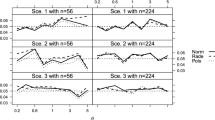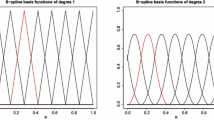Abstract
In survival analysis, it is routine to test equality of two survival curves, which is often conducted by using the log-rank test. Although it is optimal under the proportional hazards assumption, the log-rank test is known to have little power when the survival or hazard functions cross. To test the overall homogeneity of hazard rate functions, we propose a group of partitioned log-rank tests. By partitioning the time axis and taking the supremum of the sum of two partitioned log-rank statistics over different partitioning points, the proposed test gains enormous power for cases with crossing hazards. On the other hand, when the hazards are indeed proportional, our test still maintains high power close to that of the optimal log-rank test. Extensive simulation studies are conducted to compare the proposed test with existing methods, and three real data examples are used to illustrate the commonality of crossing hazards and the advantages of the partitioned log-rank tests.



Similar content being viewed by others
References
Anderson JA, Senthilselvan A (1982) A two-step regression model for hazard functions. Appl Stat 31:44–51
Bagdonavičius V, Levuliene R, Nikulin M (2012) Modelling and testing of presence of hazard rates crossing under censoring. Commun Stat-Simul Comput 41:980–991
Belongia EA, Berg R, Liu K (2001) A randomized trial of zinc nasal spray for the treatment of upper respiratory illness in adults. Am J Med 111:103–108
Breslow NE (1970) A generalized Kruskal–Wallis test for comparing K samples subject to unequal patterns of censorship. Biometrika 57:579–594
Breslow NE, Edler L, Berger P (1984) A two-step censored-data rank test for acceleration. Biometrics 40:1049–62
Chen D, Sun J, Peace KE (2012) Interval-censored time-to-event data: methods and applications. Chapman & Hall/CRC, Boca Raton
Cox DR (1972) Regression models and life tables (with discussion). J R Stat Soc Ser B 34:187–220
Eng KH, Kosorok MR (2005) A sample size formula for the supremum log-rank statistic. Biometrics 61:86–91
Fleming TR, Harrington DP (1981) A class of hypothesis tests for one and two samples censored survival data. Commun Stat Theory Methods 10:763–794
Fleming TR, Harrington DP (1991) Counting processes survival analysis. Wiley, New York
Fleming TR, O’Fallon JR, O’Brien PC, Harrington DP (1980) Modified Kolmogorov–Smirnov test procedures with application to arbitrarily right-censored data. Biometrics 36:607–625
Gehan E (1965) A generalized Wilcoxon test for comparing arbitrarily singly censored samples. Biometrika 52:203–23
Gill RD (1980) Censoring and stochastic integrals, vol 124., Mathematical centre tractsMathematical Centrum, Amsterdam
Hosmer DW, Lemeshow S (1999) Applied survival analysis: regression modeling of time to event data. Wiley, New York
Jones MP, Crowley J (1989) A general class of nonparametric tests for survival analysis. Biometrics 45:157–170
Klein JP, Moeschberger ML (2003) Survival analysis: techniques for censored and truncated data. Springer, New York
Kleinbaum DG, Klein M (2012) Survival analysis: a self-learning text, 3rd edn. Springer, New York
Kosorok MR, Lin C-Y (1999) The versatility of function-indexed weighted log-rank statistics. J Am Stat Assoc 94:320–332
Lee ET, Desu MM, Gehan EA (1975) A Monte Carlo study of the power of some two-sample tests. Biometrika 62:425–432
Lin DY, Ying Z (1994) Semiparametric analysis of the additive risk model. Biometrika 81:61–71
Liu K, Qiu P, Sheng J (2007) Comparing two crossing hazard rates by Cox proportional hazards modeling. Stat Med 26:375–391
Lin X, Wang H (2004) A new testing approach for comparing the overall homogeneity of survival curves. Biometrical J 46:489–496
Mantel N (1966) Evaluation of survival data and two new rank order statistics arising in its consideration. Cancer Chemother Rep 50:163–170
Mantel N, Stablein DM (1988) The crossing hazard function problem. Statistician 37:59–64
Mantel N, Bohidar NR, Ciminera JL (1977) Mantel–Haenszel analysis of litter-matched time-to-response data, with modifications for recovery of interlitter information. Cancer Res 37:3863–3868
Moreau T, Maccario J, Lellouch J, Huber C (1992) Weighted log rank statistics for comparing two distributions. Biometrika 79:195–198
Nahman NS, Middendorf DF, Bay WH, McElligott R, Powell S, Anderson J (1992) Modification of the percutaneous approach to peritoneal dialysis catheter placement under peritoneoscopic visualization: clinical results in 78 patients. J Am Soc Nephrol 3:103–107
Peto R, Peto J (1972) Asymptotically efficient rank-invariant test procedures (with discussion). J R Stat Soc Ser A 135:185–207
Prentice RL (1978) Linear rank tests with right censored data. Biometrika 65:167–79
Prentice RL, Marek P (1979) A qualitative discrepancy between censored data rank tests. Biometrics 35:861–867
Qiu P, Sheng J (2008) A two-stage procedure for comparing hazard rate functions. J R Stat Soc Ser B 70:191–208
Schein PD, Bruckner HW, Douglass HO, Mayer R et al, Gastrointestinal Tumor Study Group (1982) A comparison of combination chemotherapy and combined modality therapy for locally advanced gastric carcinoma. Cancer 49:1771–1777
Sun J (2006) The statistical analysis of interval-censored failure time data. Springer, New York
Tarone RE, Ware J (1977) On distribution-free tests for equality of survival distributions. Biometrika 64:156–160
Yang S, Prentice RL (2005) Semiparametric analysis of short-term and long-term hazard ratios with two-sample survival data. Biometrika 92:1–17
Yang S, Prentice RL (2010) Improved logrank-type tests for survival data using adaptive weights. Biometrics 66:30–38
Yin G, Zeng D (2005) Pair chart test for an early survival difference. Lifetime Data Anal 11:117–129
Acknowledgments
We would like to thank the Associate Editor and two anonymous referees for their careful reading and many insightful suggestions, which strengthened the work immensely. Liu’s research was supported by grants from the National Natural Science Foundation of China (11371142), the Program of Shanghai Subject Chief Scientist (14XD1401600), and the 111 Project (B14019); and Yin’s research by a grant (17125814) from the Research Grants Council of Hong Kong.
Author information
Authors and Affiliations
Corresponding author
Electronic supplementary material
Below is the link to the electronic supplementary material.
Appendix: Assumptions and Proofs
Appendix: Assumptions and Proofs
1.1 Assumptions and Lemma
We impose the following three assumptions, which correspond respectively to condition (1) of Corollary 7.2.1, and conditions (2) and (3) of Theorem 6.2.1 in Fleming and Harrington (1991). Let \(\xi = \sup \{ t: \prod _{k=0}^p \pi _k(t)>0 \}\).
Assumption 2
Assume that W(s) converges in probability to \( W_0(s)\) uniformly on [0, t] for any \(t\in [0, \xi ]\), where \( W_0(s)\) is a nonnegative, left-continuous function with right-hand limits such that \(W_0(s)<\infty \) for any \(s\le \xi \), \(W_0(s)=0\) for \(s>\xi \), and \(W_0(s+)\equiv \lim _{u\downarrow s} W_0(u)\) has bounded variation on each closed subinterval of \([0, \xi ]\).
Assumption 3
When \(\xi \notin \{ t: \prod _{k=0}^p \pi _k(t)>0 \} \), it holds for \(k=0,1, \ldots , p\) that
-
(a)
\(\int _{(0, t]} W^2_0(s) \pi _k(s)\{ 1-\Delta \Lambda _k(s) \} d\Lambda _k(s) <\infty \), and
-
(b)
\(\lim \limits _{t\uparrow \xi } \limsup \limits _{n\rightarrow \infty } P\left\{ \int _{(t, \xi ]} n^{-1}W^2(s) Y_k(s) d\Lambda _k(s) >\epsilon \right\} =0 \) for any \(\epsilon >0\).
Assumption 4
When \(\xi <\infty \), it holds for \(k=0,1, \ldots , p\) that
for any \(\epsilon >0\).
Under the above assumptions, we present a lemma below which plays a fundamental role in the proofs of all theorems in this paper. For group k (\(k=0, 1, \ldots , p\)), recall that \(S_k(t)\) and \(L_k(t)\) denote the respective survival functions of \(T_{k}\) and \(C_{k}\), \(\Lambda _k(t) = - \int _{(0, t]} {dS_k(s)}/\{1-S_k(s)\}\), and \( \pi _{\cdot }(t)= \sum _{k=0}^p \rho _k \pi _k(t)\), where \( \rho _k \equiv \lim _{n\rightarrow \infty } n_k/n \in (0, 1)\) and \( \pi _k(t) = S_k(t) L_k(t)\). Let \(M(t) = N(t) - \int _{(0, t]} Y_*(s) d\Lambda (s)\) with \(\Lambda (t) = (\Lambda _0(t), \ldots , \Lambda _p(t))^{{\mathrm {T}}}\) and
Define \(\widetilde{\Sigma }(t)\equiv (\tilde{\sigma }_{kl}(t))_{0\le k, l\le p}\) as
where \(\pi (s) = (\rho _0 \pi _0(s), \ldots , \rho _p \pi _p(s))^{{\mathrm {T}}}\).
Lemma 1
Let \(Q = (Q_0, Q_1, \ldots , Q_p)^{{\mathrm {T}}} \) be a \((p+1)\)-variate Gaussian process. Suppose that all the components Q have independent increments, \(Q_k(0)=0\) almost surely, for any \(0\le s\le t\), \( { \mathbb {E}}\{Q_k(t)\} = 0\) and \( { \mathbb {E}}\{Q_k(t)Q_l(s)\} = \tilde{\sigma }_{kl}(s\wedge t)\), where \( \tilde{\sigma }_{kl}(t) \)’s are continuous functions. Under Assumptions 2–4, as n goes to infinity, \(\tilde{Z} \) defined in (1) converges weakly to Q in \((\mathcal {D}[0, \infty ])^{p+1}\), where \(\mathcal {D}[0, \infty ] \) is the space of functions on \([0, \infty ]\) that are right-continuous with finite left-hand limits.
Proof of Lemma 1
Along the lines of the proof of Theorem 6.2.1 in Fleming and Harrington (1991), the lemma can be proved by showing that under Assumptions 2, 3 and 4, the components of \(\tilde{Z}(t)\) satisfy both (3.17) and (3.18) of Theorem 5.3.5 in Fleming and Harrington (1991). \(\square \)
1.2 Proofs of Theorems 1, 2, 3 and 4
We first prove Theorems 3 and 4. Theorems 1 and 2 follows immediately as they are the special cases of Theorems 3 and 4 with \(p=1\).
Proof of Theorem 3
When the \(p+1\) survivor functions are all equal, let \(\Lambda _c\) be the common cumulative hazard function. Then \(\widetilde{\Sigma }(t)\) reduces to
Thus, part (a) follows from Lemma 7.2.1 in Fleming and Harrington (1991).
It follows from Lemma 1 that under \(H_0\), as \(n\rightarrow \infty \), the multivariate stochastic process \( Z_{{{\tiny [-1]}}}\) converges weakly to \( Q_{{{\tiny [-1]}}}\) which has independent increments and variance–covariance matrix \(\Sigma _{{{\tiny [-1,-1]}}}(t)\). This implies that under \(H_0\), as \(n\rightarrow \infty \),
and that \(n^{-1/2} D_l(t)\) and \(n^{-1/2} D_u(t)\) are asymptotically independent. Therefore, part (b) holds.
Accordingly, the stochastic process \(\tilde{T}\) converges weakly to \(A_1(t)\) with
which implies part (c). \(\square \)
Proof of Theorem 4
Under Assumptions 1 and 2, W(t), \(Y_k(t)/n\), \( Y_{\cdot }(t)/n\) converge in probability to \(W_0(s)\), \(\rho _k\pi _{\cdot }(s)\) and \( \pi _{\cdot }(s)\) uniformly on \([0, \xi )\), respectively. Under (iv) of Assumption 1, each element of \(\Sigma (t)\) is finite, which means \(\Sigma (t)\) is well defined. Consequently, \( \widehat{\Sigma }(t) \) converges in probability to \(\Sigma (t)\), which implies part (a).
To prove part (b), we recall that \( Z(t) = \tilde{Z} (t) + \tilde{R}(t) \), where \( \tilde{Z}\) is defined in (1) and
Clearly, \(\tilde{Z}\) satisfies the conditions of Lemma 1 and converges weakly to Q, which is defined in Lemma 1. Meanwhile, by the same arguments as those in proving (a),
converges in probability to
where \(\gamma (s) = (\gamma _0(s), \ldots , \gamma _p(s))^{{\mathrm {T}}}\). This in conjunction with the weak convergence of \(\tilde{Z}\) implies that Z converges weakly to \( Q + R\). Combining the weak convergence of \( Z_{{{\tiny [-1]}}}\) and \(\hat{\Sigma }_{{{\tiny [-1,-1]}}}\), we conclude that \(\tilde{T}\) converges weakly to \(A_2(t)\) over \(t\in \Omega \), where
Consequently, T converges in distribution to \(\sup _{t\in \Omega } A_2(t)\). \(\square \)
Proof of Theorem 1
This theorem is a special case of Theorem 3 with \(p=1\). It can be verified that \(\Sigma _{{{\tiny [-1,-1]}}}(t) = \sigma (t)\) when \(p=1\), therefore results (a) and (b) follow immediately.
We need only prove result (c). When \(p=1\), part (c) of Theorem 3 implies that T converges in distribution to the supremum of
where \(Q_1\) is a Gaussian process with independent increments and variance \(\sigma \).
Let \(\{B(t): t \in [0, \infty )\}\) denote a Brownian motion, then the supremum of (6) has the same distribution as
with \(B'(t) = B\{ \sigma (\infty ) s \}/\{\sigma (\infty )\}^{1/2}\). Since \(B'(t)\) is still a Brownian motion, this leads to result (c). \(\square \)
Proof of Theorem 2
This theorem is a special case of Theorem 4 with \(p=1\). It can be verified that \(\Sigma _{{{\tiny [-1,-1]}}}(t)\), \(R_{{{\tiny [-1]}}}(t)\) and \( A_2(s)\) reduce respectively to the \(\sigma (t)\), R(t) and A (s) defined in Theorem 2. This completes the proof. \(\square \)
Rights and permissions
About this article
Cite this article
Liu, Y., Yin, G. Partitioned log-rank tests for the overall homogeneity of hazard rate functions. Lifetime Data Anal 23, 400–425 (2017). https://doi.org/10.1007/s10985-016-9365-0
Received:
Accepted:
Published:
Issue Date:
DOI: https://doi.org/10.1007/s10985-016-9365-0




